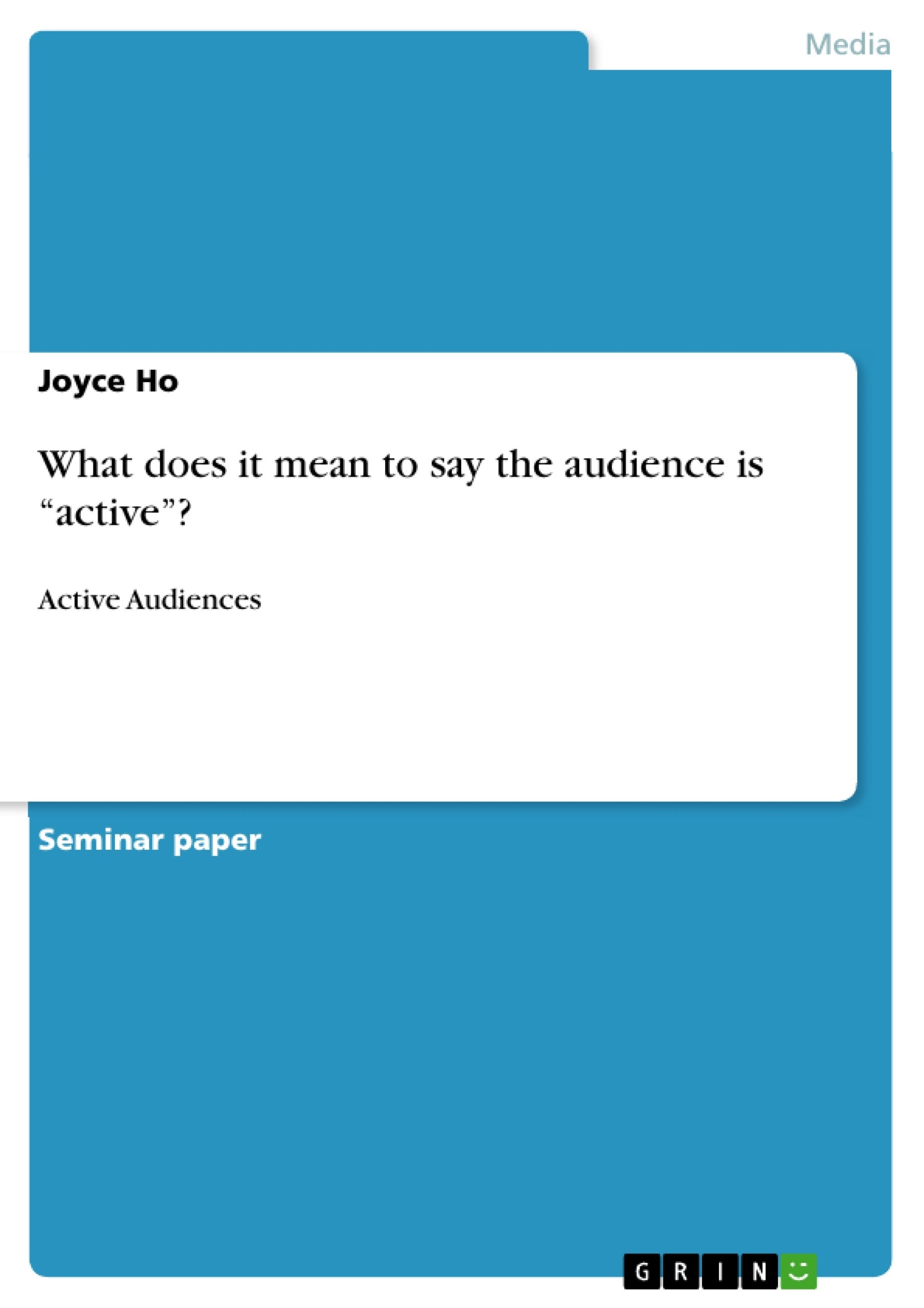People receive messages mainly from a large variety of medias, as audiences they are consuming their service through media appliances. According to Fischoff, people will consume, including buy, rend lease or steal media for two reasons, which is to be informed and to be entertained . As the general education level increases, audiences have more expectation on what media can offer them, there will not only be one-way communication from media to audiences, the action audiences would like to voice back and influence media are named “active audiences.” Traudt suggested that, audiences nowadays are more unique and they will bring a personal set of scale and filters to experience the media. And this scale and filets are based on audiences’ prior life experiences .
Topic: What does it mean to say the audience is “active”?
People receive messages mainly from a large variety of medias, as audiences they are consuming their service through media appliances. According to Fischoff , people will consume, including buy, rend lease or steal media for two reasons, which is to be informed and to be entertained[1] . As the general education level increases, audiences have more expectation on what media can offer them, there will not only be one-way communication from media to audiences, the action audiences would like to voice back and influence media are named “active audiences.” Traudt suggested that, audiences nowadays are more unique and they will bring a personal set of scale and filters to experience the media. And this scale and filets are based on audiences’ prior life experiences[2].
The usual role of audiences is a kind of message receiver, they are said to be passive, and take in ideas from what the media told them. To the traditional audiences, media is a kind of medium offers them messages without knowing what type of information they wish to receive. What Durham brought up is the idea of distributional power[3]. Media is simply distributing information and requires no response but only concerns on rating and popularity. What this communication process need is an audience, someone to receive the message that you send[4].
Whenever the audiences get the information, they will not challenge the content that the media would like to notify them, instead they will accept and received, as receivers. Normally they will believe in what they were told, if there are extreme cases of not believing in media, not much they can do to response and influence the media, and what they can do done is not real time as the media can still giving out the message. Anderson claimed that there is freedom of choice and the exercise of that choice in audiences hand and it is called "audience activity"[5]. Yet, until this stage the chances of practicing this is limited.
One of the examples of such communication pattern is news reporting on television. News is a product of the dynamic between audiences, journalists, and economic forces[6], claimed by Nightingale. So it means audiences are the one to be informed but no relations to the news production and the process. Great emphasis is placed on the text itself and its power to directly influence the audiences[7].
However, according to Nightingale, younger audiences are especially unlikely to pay attention to the news[8]. They thought news is something dull and boring with little relation to their lives. Sometimes, when audiences would like to make active choices about the news they can use, but berating them about what they should be interested in is unlikely to have much effect[9]. So as the technology improved, youngsters receive information and news from online source, which enable them to have certain effects on what they are informed. Although there are doubts on the reliability and the validity of online sources, this becomes a main stream of media lately. The big contrast of such communication pattern compare to traditional television news affected the audiences’ role. Audiences can response using their laptop or devices like mobile phone or tablets whenever they access the Internet. The active "individual” was a modern citizen-consumer patrolling the periphery of his or her consciousness with a vigilant consumerism[10], as suggested by Anderson.
[...]
[1] Stuart Fischoff. "Media Psychology: A Personal Essay in Definition and Purview."Journal of Media Psychology 10, no. 1 (2005)
[2] Paul J. Traudt. Media, audiences, effects: an introduction to the study of media content and audience analysis. Boston: Pearson/Allyn And Bacon, 2005.
[3] Meenakshi Durham, Gigi, and Douglas Kellner. Media and cultural studies: keyworks. Cambridge, MA: Blackwell Publishers, 2001.184
[4] John Hasling. The audience, the message, the speaker. 2d ed. New York: McGraw-Hill, 1976.13
[5] James Anderson A.. Communication yearbook 11. London: Sage, 1988.
[6] Nightingale, Virginia, and Karen Ross. Critical readings: media and audiences. Buckingham: Open University Press, 2003.80
[7] Philip J. Hanes "Audience in Media Studies." Aberystwyth University . http://www.aber.ac.uk/media/Students/pph9701.html (accessed October 2, 2011).
[8] Nightingale, Virginia, and Karen Ross.81
[9] Nightingale, Virginia, and Karen Ross. Critical readings: media and audiences. Buckingham: Open University Press, 2003.79
[10] James A. Anderson. Communication yearbook 11. London: Sage, 1988.
- Arbeit zitieren
- Joyce Ho (Autor:in), 2011, What does it mean to say the audience is “active”?, München, GRIN Verlag, https://www.grin.com/document/198787
-

-

-

-
Laden Sie Ihre eigenen Arbeiten hoch! Geld verdienen und iPhone X gewinnen. -

-
Laden Sie Ihre eigenen Arbeiten hoch! Geld verdienen und iPhone X gewinnen. -

-
Laden Sie Ihre eigenen Arbeiten hoch! Geld verdienen und iPhone X gewinnen. -

-
Laden Sie Ihre eigenen Arbeiten hoch! Geld verdienen und iPhone X gewinnen. -

-
Laden Sie Ihre eigenen Arbeiten hoch! Geld verdienen und iPhone X gewinnen.

